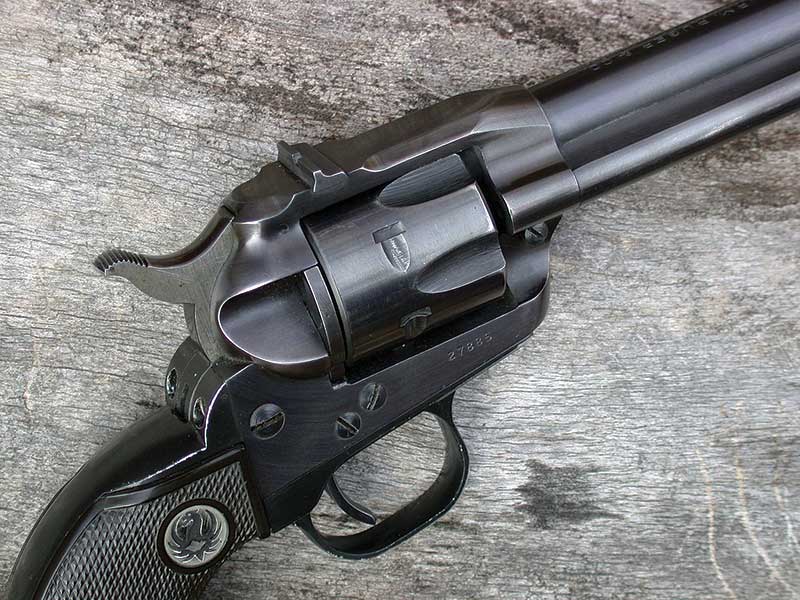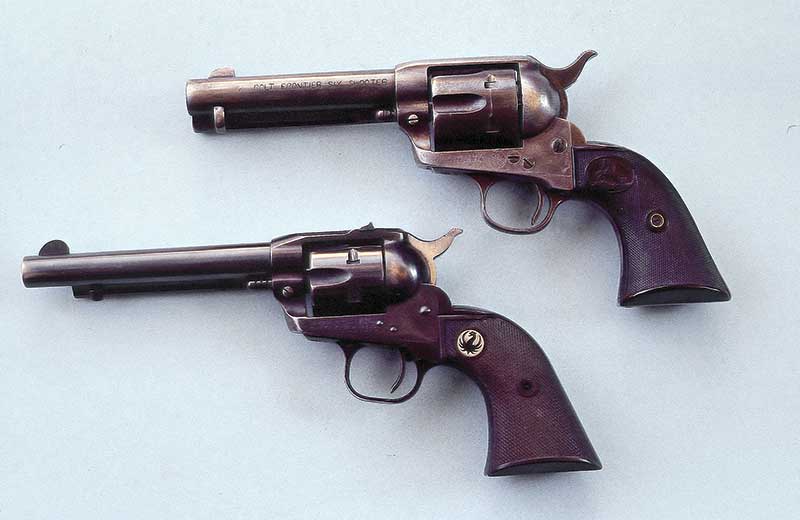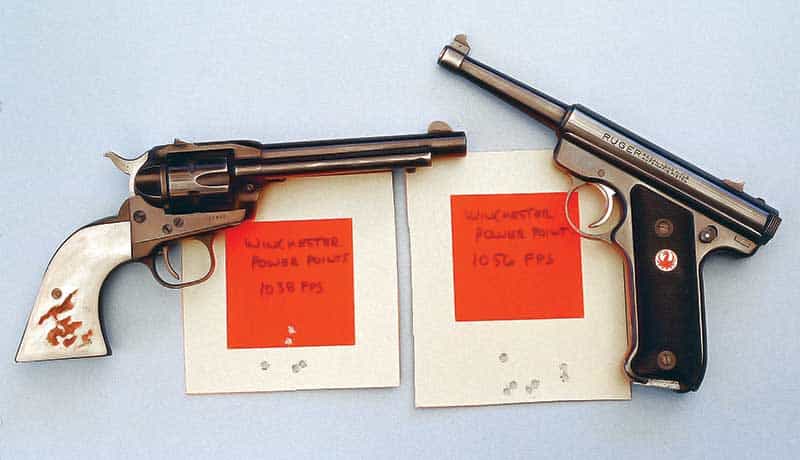Ruger's .22 Single-Six
Those were the days, my friend. We thought they’d never end.” It was 1956 and I had purchased my first very own handgun. In those days firearms were easily accessible to kids; 16 was the legal purchasing age in my area with no forms to fill out, and there was no question what the first sixgun would be. All of us paid a hard-earned $63.25 for the relatively new Ruger Single-Six .22. By then we were old enough to appreciate the smell of perfume, however, even this was not quite as sweet to our sense of smell as powder smoke and Hoppe’s #9. We had not yet learned that sixguns did not have to be cleaned after every shooting session, so the standard procedure on Saturday afternoons was to shoot all the .22s we could afford — in my case it was through a Marlin 39 Mountie as well as the Single-Six — followed by a cleaning session with Hoppe’s.
The Single-Six was Sturm, Ruger’s first revolver after successfully introducing their .22 semiauto pistol four years earlier. When Bill Ruger decided to offer his first sixgun he went against all conventional wisdom. The SAA from Colt had been dead and buried for more than 10 years, having been dropped at the beginning of World War II. The already worn machinery had been moved to the parking lot into the ravages of weather to make room in the factory for wartime production. Colt had no intention of ever producing the Model P Single Action again; they had not counted on the powerful influence of television and Bill Ruger.
In the late 1940s television arrived and began to spread throughout the country from both coasts. Those early networks had to fill their time slots in those wonderful days before 24-hour newscasts and infomercials. Live performance variety shows, sporting events, wrestling and more wrestling, and old movies were the mainstay of television at mid-century. Many of those old movies were “B” Westerns. We have progressed so far here in the beginning decade of the 21st century I now pay for cable TV and buy videos and DVDs so I can watch the same old westerns I watched as a kid. They don’t quite have the same effect today as they did, but I do enjoy going back to those wonderful days of my childhood even if only for an hour at a time.
Those old western movies featured the likes of Roy, Gene, Hoppy, Wild Bill, Tim, Buck, Rocky, Lash and dozens of others all of whom used single action sixguns to tame their part of the West. Anyone who doesn’t know all of these men by their first names is definitely lacking a truly solid basic education. A demand arose for single action sixguns, often fueled by those who had never even fired a revolver. The only Colts available were on the used market and the demand for the old Peacemakers and higher prices walked hand-in-hand. Ruger read the situation and made two landmark decisions. He would introduce a new single action and he would also chamber it in America’s favorite and most affordable cartridge, the .22 Long Rifle.
Notta’ Copy
Ruger did not just copy the Colt Single Action Army, except for the shape and size of the grip frame. During the run of what we now call 1st Generation Colt SAAs some were chambered in .22, making them quite heavy and bulky for the cartridge. Bill Ruger downsized the cylinder and mainframe to more closely fit the .22 Long Rifle, modernized the action by replacing the leaf mainspring and trigger/bolt springs with virtually unbreakable coil springs, while the two fragile arms on the bolt itself were replaced by a solid bolt actuated by a coil spring operated plunger on the hammer. The flat hand-spring was also replaced by a coil spring. The most fragile parts on the original Colt Single Action were the hand-spring and the bolt spring, and Ruger’s modifications made the Single-Six virtually unbreakable. In fact, Ruger set up a demonstration at the NRA Show with the machine cocking and dry firing a Ruger Single- Six 24 hours a day. During the show the machine broke — the Single-Six did not.
As a further improvement to the original Colt SAA, Ruger flat-topped the frame and replaced the hog wallow rear sight trough with a rear drift sight adjustable for windage, set in a dovetail. Even though my first Single-Six cost $63.25 when those in our group were averaging 90 cents an hour, it was still a bargain compared to the prices commanded by pre-war Colts. We couldn’t have afforded to shoot those old Colts even if we did manage to scrape up the asking price. I did come up with a beautiful Colt Single Action .38-40 six months later with a price tag of $90 and definitely could not afford the cost of ammunition. Each time I shot it my rounds were rationed to single-digit numbers, not the hundreds of rounds I go through now.
In order to be able to offer such an excellent, virtually indestructible revolver for the price, it was necessary for Ruger to come up with new manufacturing techniques. Previous to this, most mainframes were forged — Bill Ruger introduced investment casting. He also took shortcuts by having the two-piece steel grip frame of the Colt replaced by a one-piece aluminum alloy affair. Early guns also had flat loading gates instead of the beautifully contoured gate of the Single Action Army. The blue finish of the Single-Six was certainly adequate but nowhere near the beautifully blued and case-hardened look of the Single Action Army. Then, as now, Ruger products were aimed at the so-called “blue collar” market consisting of those shooters who wanted every day working firearms capable of lasting for generations.
A Legend
The first Ruger Single-Six arrived in 1953 with a standard 51/2″ barrel, an all blue finish, and a price tag of $57.50. The original prototype Single-Six had a case-colored frame, however Ruger decided to go with the all blue finish. Many of the early guns had a somewhat reddish or purple colored mainframe, so if you see that on an old gun, it may not mean it’s a re-blue.
In 1957 the flat loading gate was changed to the Colt-style contoured loading gate. Two years later, two new barrel lengths were added, 45/8″ and 91/2″ and the shortest is the rarest. This same year, 1959, saw the first Convertible Model Rugers offered with two cylinders, one in .22 Long Rifle one in .22 Winchester Magnum. Single-Sixes were also offered in .22 Winchester Magnum alone. During the late 1950s and early 1960s Ruger also offered the Lightweight Single-Six. Both steel and alloy-frame versions were offered, however the alloy cylinder proved to be inadequate and was soon replaced with a steel cylinder.
In 1962 production of the original .22 Single-Sixes ended as we entered what is commonly known as the Old Model versions when applied to the centerfire Ruger single actions of the time. The grip frame was changed to allow more room behind the trigger guard. The original grip frames, identical in shape and size to the Colt Single Action Army, were marked XR3; the newer frames were became XR3-RED. Original grips had been checkered black rubber with black eagle medallions, however in 1960 these were phased out in favor of walnut grip panels, and all of the “2nd Generation” Single-Sixes are fitted with walnut stocks. Most of these also came with extra .22 Magnum cylinders. The Single-Six became even more versatile in 1964 with the introduction of the Super Single-Six with adjustable sights. This certainly made sense, as any Convertible sixgun should have adjustable sights to allow for sighting-in with different loads.
More Upgrades
By 1972 well over one-half million Single-Sixes had been produced and it was time for the next major change with the coming of the New Model Single-Sixes. In 1973 Ruger changed the concept and design of single action revolvers once again by the addition of an automatically engaged safety transfer bar. Up to this time all single action cartridge firing sixguns were only safely carried if the hammer was allowed to rest on an empty chamber. Some percussion revolvers, as does Ruger ’s Old Army, have a notch between chambers to allow the hammer to rest safely.)
Rugers New Model Single-Six could now be carried safely fully loaded. The hammer did not contact the firing pin in its resting position. When the New Model Single-Six is cocked a transfer bar moves upward to allow the firing pin to be contacted when the hammer is pulled. Up to this time all Single-Sixes had the traditional three screws in the side of the frame; they were now replaced with two pins. Any Ruger single action with three screws MUST be carried with the hammer down on an empty chamber.
Until very recently all Ruger New Model Single-Sixes were fitted with adjustable sights, however a few have been made with Colt SAA style sights as a rimfire companion to the centerfire Vaquero. New Model Single-Sixes are found in four barrel lengths, 45/8″, 51/2″, 61/2″ and 91/2″ all fitted with extra .22 Winchester Magnum cylinders.
In 1974, Ruger began offering the New Model in stainless steel, also making it a most versatile and weather resistant .22 sixgun. I can’t think of a more practical .22 sixgun than an adjustable-sighted, stainless steel, single action revolver, with an extra .22 Magnum cylinder. My favorite New Model Single-Six, apart from my custom Single-Sixes by Andy Horvath, is the Hunter Model complete with a heavy ribbed 71/2″ barrel, bead front sight, and scalloped to accept Ruger scope rings. This little .22 has it all.
I doubt most kids today enjoy .22 sixguns as much as we did. We were not handicapped with the existence of computers, video games, VCRs, CDs, DVDs, portable plug-in-the-ear music, cell phones, MTV and all the other results of progress. We made our own enjoyment and were active participants — instead of viewers and listeners. In the 1950s I enjoyed Ruger .22s with my fellow teenage shooters. Today I enjoy them even more, shooting with my grandkids. Perhaps those were the days, however it’s more likely these are the days — at least for me.
Subscribe To American Handgunner

Get More Revolver Content Every Week!
Sign up for the Wheelgun Wednesday newsletter here:









